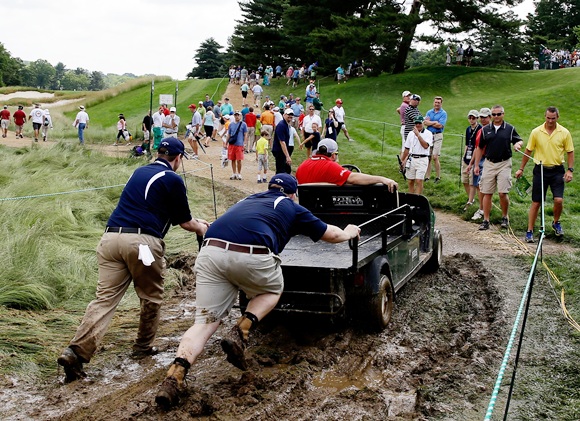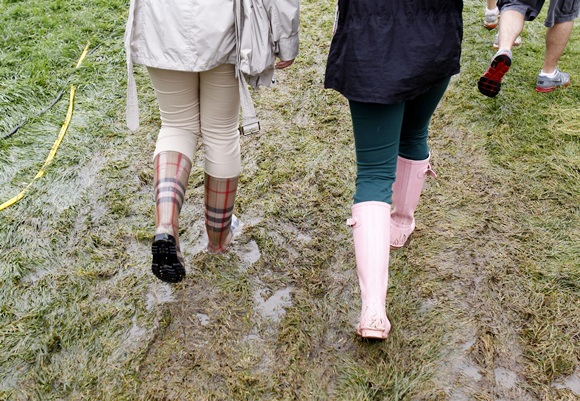 | « Back to article | Print this article |
Players worried that the mud will stick at US Open
Heavy rain at this week's US Open has raised the question of whether mud balls could affect the outcome of the championship.
Despite two days of warm, drying weather after more than six inches (15 centimetres) fell on the Merion course, more rain was forecast for Thursday's opening round.
When the ground is so heavy, it is not uncommon for mud to stick to balls hit in the fairway, making it harder to control the next shot.
Graeme McDowell, the 2010 US Open winner at PebbleBeach, said the randomness of getting a mud ball could throw the competitive balance off.
'I think there's an element of luck anytime you win a golf tournament'
"It is an element of chance as to how your ball pitches in the fairway, does it pitch in the upslope, does it pitch in the downslope, are you a low ball hitter or a high ball hitter, how much mud is your ball going it to pick up," McDowell said.
"If it's a long shot it literally can cost you shots. So it's unfair."
Three-times US Open champion Tiger Woods was less concerned.
"I think there's an element of luck anytime you win a golf tournament," Woods said.
"The good news is that most of these holes that we're going to have potential mud balls on we're going to have short irons in. You can get the ball on (the green) a little easier with a short iron."
On the PGA Tour, concerns over mud balls are addressed by utilising a lift, clean and place provision in muddy conditions.
However, the US Golf Association, a staunch defender of the basic tenets of the game, has always insisting on a strict adherence to the rule of playing the ball as it lies. Although it allows relief for plugged shots.
'I think mud balls are a problem, they're unfair'
Steve Stricker, playing in his 18th US Open, said he believed golf balls used by professionals these days were more prone to mud.
"We're more apt to get a mud ball nowadays than we were earlier on in my career," said Stricker. "It seems like (it takes) less mud to affect the ball.
"The balls have been made to spin less...so it doesn't take much mud to really affect that ball."
Northern Ireland's McDowell said he thought that some conditions called for lift, clean and place.
"I get the fact that the USGA and the Masters Committee and the R&A, they don't like giving the golf ball in hand, club length, lift, clean and place, because you can use that rule to your advantage, you can change your angle," he said.
"But I think mud balls are a problem. I think they're unfair. I think golf is designed to be played from a closely mown fairway. If you hit it in that fairway you deserve a great line and a great opportunity to attack the green surface."
'You have to adapt your game'
David Graham, the first Australian to win a US Open with his 1981 triumph at Merion, scoffed at that idea.
"That's golf. It's just the luck of the draw. You get a good lie, you get a bad lie, you see two guys drive it 275, 300 yards, one finishes in a divot, the other one's got a perfect lie.
"So it's the rub of the green and maybe that's one of the facets of golf that make it so intriguing is to be able to play and adapt to those kinds of things."
Lee Trevino, who won the 1971 US Open at Merion in a playoff with Jack Nicklaus, said there were ways to ward off the dreaded mud ball.
"I had an advantage in the mud. I hit a low ball," Trevino said. "Very seldom my ball ever picked up mud because I went so low that it cleaned itself before it stopped rolling," he said, drawing laughter from reporters.
"You think that's funny, but it's true. And you have to adapt your game to that."



